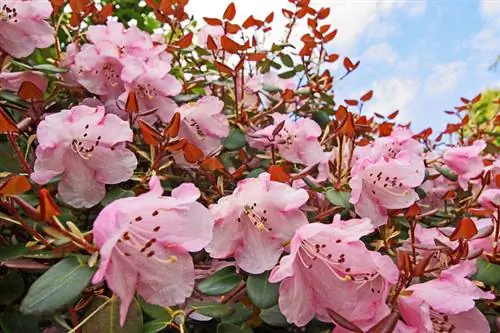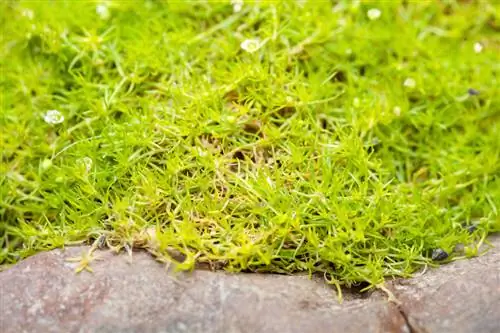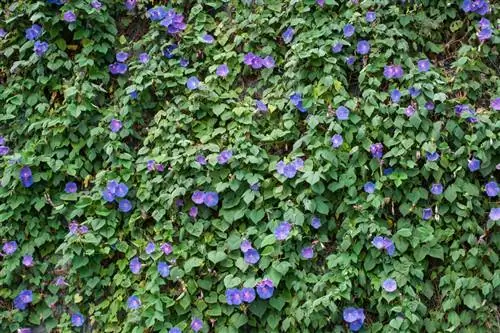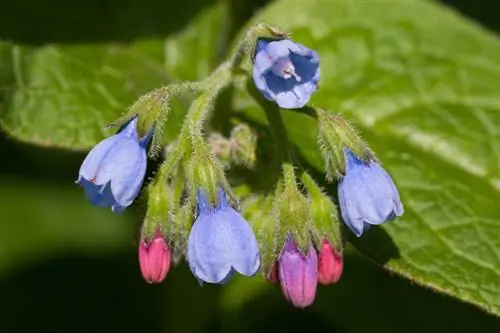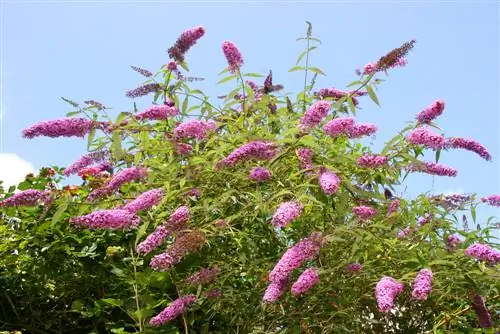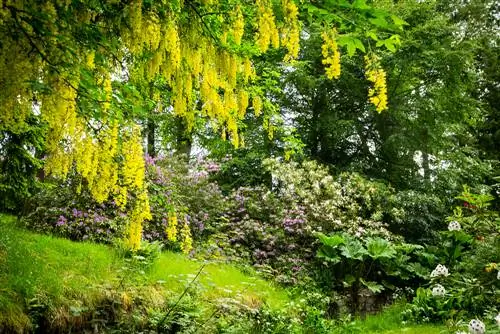- Author admin [email protected].
- Public 2024-01-02 03:03.
- Last modified 2025-06-01 06:02.
When you replant or move a rhododendron, the question arises: Where is the optimal location? Which soil does the evergreen ornamental shrub prefer? What rhododendrons love and what they don't are clearly summarized here

Which location is optimal for a rhododendron?
The optimal location for a rhododendron is a shady to semi-shady place with loose, slightly acidic soil (pH value between 4.0 and 5.0), low in lime, rich in humus or enriched with acidic peat. The plant needs sufficient minerals and nutrients as well as wind protection.
Rhododendron wish list location and soil
Originally from. Rhododendron from Far Eastern high regions. There they thrive on thin layers of humus in high humidity. They love light and shade under deep-rooted trees such as oak, pine and fir. Light foliage or a canopy of needles provides protection from direct midday sun and acts as an ideal backdrop for the voluminous rhododendron flowers.
Due to the wide range of locations from light to shade, rhododendrons feel at home almost anywhere. Nevertheless, you should always observe the following optimal soil and location conditions:
- shady to semi-shady location
- loose, slightly acidic soil (pH value 4.0 - 5.0)
- low in limestone, permeable to water and air
- Humus or acidic peat
- Moorbed soil
- Windbreak
- sufficient minerals and nutrients
The optimal rhododendron location in home gardens
Those cultivated in our gardens. Rhododendron species love wind-protected, partially shaded locations with high humidity. Climatically, they prefer cool, moist summers and short cold periods with little frost in winter.
Ideal shade providers for rhododendrons: deep-rooted, light deciduous or coniferous trees or the north wall of a building. Too much shade restricts flower formation and the growth becomes loose and sparse.
Basically, the higher the humidity, the more likely the rhododendron will tolerate a sunny location and vice versa. Alpine, winter-hardy wild varieties from locations above the tree line can also tolerate full sun, such as:
- Alpine rose Rhododendron hirsutum
- Rhododendron ferrugineum
- Rhododendron carolinianum
- Rhododendron russatum
The ideal soil condition
Rhododendrons prefer humus-rich, acidic, evenly moist soil and cool soils. The optimal pH value of the soil is between 4.0 and 5.0. Exception: The INKARHO rhododendron varieties are particularly suitable for alkaline and calcareous soils.
Waterlogging and soil compaction lead to a lack of nitrogen and oxygen. The result: Harmful organisms such as Phytophthora spread and the rhododendron dies.
An excessive pH value of 6.0 or more limits the availability of iron. The plant's growth slows down significantly. The result is growth depression and chlorosis on the leaves. Countermeasures: Improving the soil to correct the pH value and fertilizing with trace element preparations lead to the regeneration of the plant.
Keep your eyes open when buying a rhododendron
When buying a rhododendron, look for compact growth, he althy, dark green leaves and lots of flower buds. He althy, strong plants acclimatize and grow better in the new location in your garden. Hands off rhododendrons with brown or yellow leaves, these are indications of a root disease or nutrient deficiency.
Tips & Tricks
Rhododendron can be used in all areas of the garden: as an eye-catcher in the middle of the garden or as colorful highlights in individual areas. They also offer flower-rich privacy screens for balconies and terraces as hedges or potted plants.

